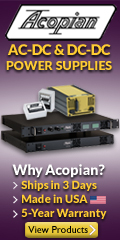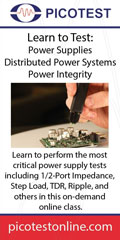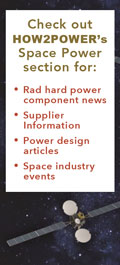 |
|
IN THIS ISSUE:
» Developing A 25-kW SiC-Based Fast DC Charger (Part 1): The EV Application
» The Engineer’s Guide To EMI In DC-DC Converters (Part 17): Active And Hybrid Filter Circuits
» A Four-Decade, Integrated Current-Sensing Solution With Extended Supply Range
» Focus On Magnetics:
Bunched Vs. Cabled: Litz Wire Bundle Twist Geometry Influences Proximity Effects
» Spotlight On Safety & Compliance:
Safety On The Bench: Hazards And Precautions In The Power Electronics Lab
» New Power Products
» Industry Events
- ECCE 2021: Expanding Industry Participation and Connections In A Hybrid Format
- APEC 2021 Will Be Online Only
» Other Top Power News
From the Editor's Desk David G. Morrison
Editor, HOW2POWER TODAY

Since the pandemic hit early last year, the conference and tradeshow schedule has been in continuous disarray. We have witnessed this pattern where in-person events initially postpone by a few or several months, and then they cancel or go virtual. Sometimes they postpone and go virtual in one step. Nevertheless, the basic patterns seem to be repeating this year, even as the growing distribution of the vaccines brings the hope that we’re getting closer to holding in-person events again. But for now, one of the side effects of the pandemic has been that summer seems to be just as good a time as any to hold a conference or tradeshow. Fewer people are traveling for business or pleasure, so why not? The summer conference calendar is more crowded than ever. I expect that even after live events return, many will continue to offer their programs virtually, and summer will remain busy with such activities as the separation between work time and personal time continues to blur. While virtual events are changing the way we learn and interact, and despite the prevalence of simulation, the power electronics profession remains grounded in the physical world of the development lab. While much has been written on how to make measurements accurately on power electronics, relatively little has been written on how to do so safely. Paul Schimel explores this subject in this month’s Safety & Compliance column. The safety topic will only become more pressing as designs such as the 25-kW fast EV charger described here by Oriol Filló and his colleagues become more common. This issue also brings features on active EMI filtering, current sensing with extended supply range, the effects of litz wire bundle twist geometry, the latest power product news and more.
|
|

|
HOW2POWER EXCLUSIVE DESIGN ARTICLES 
|
Developing A 25-kW SiC-Based Fast DC Charger (Part 1): The EV Application
by Oriol Filló, Karol Rendek, Stefan Kosterec, Daniel Pruna, Dionisis Voglitsis, Rachit Kumar and Ali Husain, ON Semiconductor, Phoenix, Ariz.
Along with the acceleration in the adoption of electrical vehicles (EVs), the demand for fast charging infrastructure is increasing. If you are an application, product or design engineer working in the power electronics field, sooner or later you could be involved in the design of one such charging system. A basic question might arise here, especially if it is the first time you are facing such a challenge. How and where should I begin? What are the key design considerations and how should I address them? ON Semiconductor’s EMEA Systems Engineering team is gearing up to help designers address this challenge as we’ll demonstrate by designing and developing a 25-kW fast dc charger based on SiC power integrated modules (PIMs).
Read the article…
|

Higher power dc chargers are typically
built in a modular fashion, where power
blocks of 15 to 75 kW (and above) are
stacked together in a single cabinet. |

|

An AEF enables attenuation at the
fundamental switching frequency and
low-order harmonics, while relatively
small-sized passive components
provide supplementary attenuation
at higher frequencies where the gain
of the active stage rolls off. |
The Engineer’s Guide To EMI In DC-DC Converters (Part 17): Active And Hybrid Filter Circuits
by Timothy Hegarty, Texas Instruments, Phoenix, Ariz.
Minimizing the size, weight and cost of the EMI filter stage remains a priority for system designers. To this end, there have been numerous efforts over the past three decades in the application of active EMI filters (AEFs), with results indicating a substantial reduction in filter size and volume relative to a passive-only solution. Along with an AEF, the use of another passive component helps improve the overall attenuation and bandwidth—these circuits are known as hybrid EMI filters (HEFs). This article reviews the theoretical background of AEF circuits in terms of noise sensing, noise injection and control techniques. Experimental results from an automotive synchronous buck regulator circuit—using a controller with integrated AEF functionality for DM noise cancellation—illustrate the benefits available to designers in terms of EMI performance and space savings.
Read the article…
|

A Four-Decade, Integrated Current-Sensing Solution With Extended Supply Range
by Bich Pham and Ashwin Badrinarayanan, Maxim Integrated, San Jose, Calif.
There is a growing need to measure a wide range of current in a system from miniscule current levels up to several amperes of current. Current-sense amplifiers used in combination with external sense resistors are a traditional choice for measuring current in these types of applications. However, there are performance limitations associated with this option, particularly with respect to dynamic range. This article introduces a resistorless, greater than four-decade dynamic range current-sensing solution and describes a simple method to extend its supply voltage range from 6 V up to 36 V using only a Zener diode and two MOSFETs.
Read the article…
|

Although the technique described
here is not new, applying it to the
MAX40016 offers a solution that
achieves the extended supply range
while also providing wide dynamic
range and high accuracy. |


FOCUS ON MAGNETICS 
Sponsored by Payton Planar Magnetics
A monthly column presenting information on power magnetics design, products, or related technology |

Bunched Vs. Cabled: Litz Wire Bundle Twist Geometry Influences Proximity Effects
by Dennis Feucht, Innovatia Laboratories, Cayo, Belize
Litz wire is a name for strands of individual wire conductors twisted or braided into a bundle that can then be wound on a core bobbin to form a winding. Each turn of the bundle is a winding turn, and within it are strands of wire. A winding bundle can simply be Ns strands twisted together, or can consist of sub-bundles of twisted wire which are twisted together to form the overall bundle. Commercial Litz wire usually consists of sub-bundles and is more elaborate to construct, especially if it is braided. This article describes some of the geometric features of Litz wire consisting of multiple twisted bundles and their magnetic effects, mainly with respect to proximity effects.
Read the full article…
|

 |
 |

SPOTLIGHT ON SAFETY & COMPLIANCE 
Sponsored by Power Integrations
A monthly column discussing standards and regulatory requirements affecting power electronics |

Safety On The Bench: Hazards And Precautions In The Power Electronics Lab
by Paul L. Schimel, Microchip Technology, Chicago, Ill.
It’s no mystery that we, as power electronics engineers go through tremendous pains and trials to deliver a product that fulfills the mission requirements demanded by the application and the market. These requirements include reliability, environmental, safety and electromagnetic radiation, conduction and susceptibility constraints, and in some cases heavy ion, gamma ray and neutron events. We take all efforts to assure that the path of least resistance is upheld for the circuitry. This is the path of most resistance for us, but this is the duty. The standards can vary from ambiguous to crystal clear across space, mil, medical, aerospace, defense, consumer, automotive, industrial. But what happens on the bench in the lab during prototype and evaluation stages—before the codified standards apply? Shouldn’t that be safe too?
Read the full article…
|

 |
 |

 |
|
|

 — POWER PRODUCTS IN 3 IMAGES OR LESS — POWER PRODUCTS IN 3 IMAGES OR LESS 
|


From Faraday Press, Transfer
Functions of Switching
Converters. |
Book Explains How To Obtain Transfer Functions Of Popular SMPS Topologies
 Photo: Christophe Basso’s new book on small-signal modeling of switched-mode power supplies, Transfer Functions of Switching Converters, Fast Analytical Techniques at Work with Small-Signal Analysis, teaches designers how to derive transfer functions for a wide range of topologies and control schemes, including the most popular types as well as some of the more exotic ones. Photo: Christophe Basso’s new book on small-signal modeling of switched-mode power supplies, Transfer Functions of Switching Converters, Fast Analytical Techniques at Work with Small-Signal Analysis, teaches designers how to derive transfer functions for a wide range of topologies and control schemes, including the most popular types as well as some of the more exotic ones.
See the full story…
|


Texas Instruments’
LM25149-Q1 and LM25149
dc-dc controllers. |
DC-DC Controllers Integrate Active EMI filter For Smaller Solution Size
 Diagrams: These 42-V synchronous buck controllers with ultra-low IQ and integrated active EMI filter enable engineers to cut the area of the external EMI filter in half (compared with conventional passive EMI filters), lower the conducted EMI of the power design by as much as 55 dBµV across multiple frequency bands, or achieve a combination of reduced filter size and low EMI, according to the vendor. Diagrams: These 42-V synchronous buck controllers with ultra-low IQ and integrated active EMI filter enable engineers to cut the area of the external EMI filter in half (compared with conventional passive EMI filters), lower the conducted EMI of the power design by as much as 55 dBµV across multiple frequency bands, or achieve a combination of reduced filter size and low EMI, according to the vendor.
See the full story…
|


 |

|


Power Integrations’ LNK3207
ac-dc converter ICs. |
AC-DC Converter ICs Ease Design For Appliances, Sensors And Meters
 Photo: The LinkSwitch-TN2 devices are highly efficient offline switcher ICs with integrated power MOSFET and system-level protection for low component-count power supplies. The new LNK3207 members of the family incorporate a 725-V power switch with lower RDS(ON) than previous models, which allows them to deliver 60% higher current in CCM mode. Photo: The LinkSwitch-TN2 devices are highly efficient offline switcher ICs with integrated power MOSFET and system-level protection for low component-count power supplies. The new LNK3207 members of the family incorporate a 725-V power switch with lower RDS(ON) than previous models, which allows them to deliver 60% higher current in CCM mode.
See the full story…
|

 |

|


Infineon Technologies’
2ED2103S06F/2ED2104S06F
half-bridge and
2ED2110S06M/2ED2101S06F
high- and low-side gate drivers. |
Half-Bridge And High-Side/Low-Side Gate Drivers Are Tailored For Fast Switching
 Diagrams: These additions to the EiceDRIVER portfolio are 650-V half-bridge gate drivers and 650-V high- and low-side gate drivers. Based on the company’s silicon-on-insulator technology, these devices are said to provide leading negative VS transient voltage immunity along with monolithic integration of real bootstrap diodes. Diagrams: These additions to the EiceDRIVER portfolio are 650-V half-bridge gate drivers and 650-V high- and low-side gate drivers. Based on the company’s silicon-on-insulator technology, these devices are said to provide leading negative VS transient voltage immunity along with monolithic integration of real bootstrap diodes.
See the full story…
|


 |

|


Maxim Integrated Products’
MAX17227A and
MAX17291 boost converters
and MAX38911 LDO. |
Power ICs Extend Battery Life In Consumer, Industrial, Healthcare And IoT Designs
 Photo: The 2-A nanoPower boost converter, the high-voltage, 1-A boost converter and the 500-mA LDO shrink size of battery-operated devices by offering what’s described as the industry’s lowest quiescent current and up to 50% smaller size than the closest competitive solutions. These devices also have features such as short-circuit protection and high PSRR to help IoT systems overcome disruptions in harsh environments. Photo: The 2-A nanoPower boost converter, the high-voltage, 1-A boost converter and the 500-mA LDO shrink size of battery-operated devices by offering what’s described as the industry’s lowest quiescent current and up to 50% smaller size than the closest competitive solutions. These devices also have features such as short-circuit protection and high PSRR to help IoT systems overcome disruptions in harsh environments.
See the full story…
|


|










|

INDUSTRY EVENTS  |
|
ECCE 2021: Expanding Industry Participation and Connections In A Hybrid Format
As a result of the COVID-19 pandemic, for the first time since its creation, ECCE 2020 was presented in a virtual format. And with that novel experience to support the organizers’ vision, the ECCE 2021 team is planning the largest international energy conversion conference and exposition in a hybrid format where the virtual component will be prepared and tested during most of 2021 to ensure it runs smoothly by October. For an in-depth look at this year’s plans, see chair Giovanna Oriti’s article, “ECCE 2021: Expanding Industry Participation and Connections: Organizing a Hybrid Format for Unprecedented Growth” in IEEE Power Electronics magazine.
Read the full story… |

|
|
APEC 2021 Will Be Online Only
Registration is now open for the 36th annual Applied Power Electronics Conference. Previously scheduled as a live, in-person event in Phoenix, Ariz., APEC 2021 has been recast as an entirely online event due to continuing uncertainty over in-person participation. The organizers have announced that APEC 2021 will be presented as a virtual event and will take place June 14-17, 2021, on the Social27 platform.
Read the full story… |

 |
|  |

OTHER TOP POWER NEWS
|
|
 A new website, MatDirjish.com represents extensive observations in the electronic design, technology, art, and music arenas. Many engineers/designers/EOEMs found their way into technology via art and/or music, so there’s something here to feed those extracurricular interests. Extra focus is on new tech products, designs, and concepts, particularly in the power and alternative energy arenas. Since everything in our existence is an electro-mechanical event, humans, and their tech devices, cannot exist without power: ac & dc. A new website, MatDirjish.com represents extensive observations in the electronic design, technology, art, and music arenas. Many engineers/designers/EOEMs found their way into technology via art and/or music, so there’s something here to feed those extracurricular interests. Extra focus is on new tech products, designs, and concepts, particularly in the power and alternative energy arenas. Since everything in our existence is an electro-mechanical event, humans, and their tech devices, cannot exist without power: ac & dc.


 AVX will deliver three technical presentations and two training seminars, while showcasing its high-reliability MIL-spec components at the Components for Military & Space Electronics Conference, April 19–23. AVX will deliver three technical presentations and two training seminars, while showcasing its high-reliability MIL-spec components at the Components for Military & Space Electronics Conference, April 19–23.


|

 Nexperia and United Automotive Electronic Systems are partnering to jointly develop automotive applications using GaN technology. Nexperia and United Automotive Electronic Systems are partnering to jointly develop automotive applications using GaN technology.



 Richardson Electronics expands power management technology portfolio with Cornell Dubilier’s high energy storage, pulse discharge capacitors. Richardson Electronics expands power management technology portfolio with Cornell Dubilier’s high energy storage, pulse discharge capacitors.



 ROHM has opened a new joint technology lab with Sanden Huayu in Shanghai, China. This laboratory contains important equipment required for evaluating devices and automotive applications, primarily automotive air-conditioning systems. ROHM has opened a new joint technology lab with Sanden Huayu in Shanghai, China. This laboratory contains important equipment required for evaluating devices and automotive applications, primarily automotive air-conditioning systems.



ABOUT THIS NEWSLETTER: Thank you for reading HOW2POWER TODAY.
How2Power sends no more than one e-mail per month to registered users. Continuing your subscription ensures you'll receive future newsletters. Manage Your Subscription
©2020 All rights reserved. www.how2power.com
|
|